Themed collection Perovskites

Toward durable all-inorganic perovskite solar cells: from lead-based to lead-free
This highlight article summarizes the empirical advances in stabilizing the metastable phases of CsPbI3, aiming to provide useful guidelines to accelerate the development of phase-stable CsSnI3 for durable lead-free PV applications.

Chem. Commun., 2024,60, 12287-12301
https://doi.org/10.1039/D4CC04000G
Growth mechanism of metal halide perovskite single crystals in solution
The difference in the growth mechanism between MHP SCs in solution and traditional SCs synthesized by the melting method is specifically focused on, encompassing a discussion of the dissolution, nucleation, and growth processes.
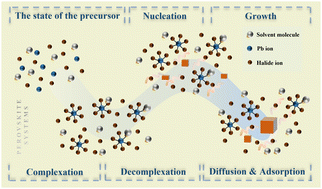
Chem. Commun., 2023,59, 8758-8768
https://doi.org/10.1039/D3CC02241B
A review: strategies for reducing the open-circuit voltage loss of wide-bandgap perovskite solar cells
Wide-bandgap perovskite solar cells suffer from severe VOC loss. The reported studies on reducing the VOC deficit in terms of interface modification, charge transport layer engineering, and additive engineering are systematically reviewed.

Chem. Commun., 2025,61, 1063-1086
https://doi.org/10.1039/D4CC05131A
Solvent–antisolvent interactions in metal halide perovskites
This feature article outlines the impact of solvent–antisolvent interactions on the film formation processes of metal halide perovskites.

Chem. Commun., 2023,59, 10588-10603
https://doi.org/10.1039/D3CC02090H
Lead-free perovskite-inspired semiconductors for indoor light-harvesting – the present and the future
Perovskite-inspired absorbers are promising for sustainable indoor light-harvesting. Defect mitigation and device operational stability need attention to accelerate the development of air-stable and low-toxicity photovoltaics.

Chem. Commun., 2023,59, 8616-8625
https://doi.org/10.1039/D3CC01881D
Compositional gradient engineering and applications in halide perovskites
The compositional gradient engineering of halide perovskites is summarized, where carrier extraction can be promoted in optoelectronic devices and the multiple components on one device facilitate multi-spectral detection/emission applications.
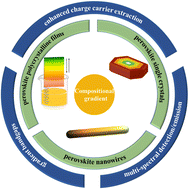
Chem. Commun., 2023,59, 5156-5173
https://doi.org/10.1039/D3CC00967J
Halide perovskites for sensitive, stable and scalable X-ray detection and imaging
Halide perovskites are developed to be sensitive, stable and scalable in the future commercialization process.

Chem. Commun., 2023,59, 5016-5029
https://doi.org/10.1039/D3CC00969F
Precise modulation strategies of 2D/3D perovskite heterojunctions in efficient and stable solar cells
We summarize various effective methods for controlling the film thickness and structural phases in 2D/3D perovskite heterojunction structures and discuss possible solutions to improve the performance of perovskite devices.

Chem. Commun., 2023,59, 4128-4141
https://doi.org/10.1039/D2CC07048K
Composite SnO2–K2S ETL for energy level regulation and electron mobility enhancement in perovskite solar cells
PSCs often use SnO2 as the ETL, issues like energy level mismatch, interface defects reduce efficiency. We found that adding K2S to SnO2 effectively adjusts energy levels and fills oxygen vacancies, improving electron mobility and interface quality.

Chem. Commun., 2025,61, 8540-8543
https://doi.org/10.1039/D5CC00194C
Solution triggered facile ion-exchange and phase transformation of ternary cesium-copper halide pseudo-perovskites
A simple, fast, and easily tunable post-synthetic bromide/iodide exchange method is presented to alter the halide-composition of polycrystalline Cs3Cu2Br5 layers.

Chem. Commun., 2025,61, 3508-3511
https://doi.org/10.1039/D4CC06335J
Interstitial and substitutional doping of Mn2+ in 2D PEA2PbBr4 and BA2PbBr4 perovskites
Mn2+ doping imposes intriguing optoelectronic properties on lead-halide perovskites; however, its impact on their crystal structure remains unclear.

Chem. Commun., 2024,60, 14960-14963
https://doi.org/10.1039/D4CC04074K
Unveiling the effect of codoping in strontium ferrite for oxygen evolution in alkaline media
Co and Ni atom codoped strontium ferrite exhibits enhanced performance toward the OER in alkaline media.

Chem. Commun., 2024,60, 14605-14608
https://doi.org/10.1039/D4CC04145C
Composition tunable and stable spontaneous emission and lasing in Cd-alloyed perovskite microdisks
All-inorganic Cd-alloyed perovskite microdisks were synthesized by pressure-assisted high temperature recrystallization. The microdisks showed composition tunable and temporally stable photoluminescence.

Chem. Commun., 2024,60, 13730-13733
https://doi.org/10.1039/D4CC04488F
One-dimensional hybrid copper halides with high-efficiency photoluminescence as scintillator
The organic–inorganic hybrid halide [APCHA]Cu2I4, exhibits green emission under both UV and X-ray excitation. It shows excellent photoluminescence and radioluminescence properties, making it suitable for X-ray detection and imaging applications.

Chem. Commun., 2024,60, 10528-10531
https://doi.org/10.1039/D4CC03296A
Self-trapped emissions in 2D lead-free halide perovskites driven by divalent spacer cations
Investigation of sodium/indium-based 2D double perovskites with mono- and divalent organic spacers reveals significant optoelectronic impacts in a novel lead-free Dion–Jacobson phase due to octahedral distortions.

Chem. Commun., 2024,60, 9066-9069
https://doi.org/10.1039/D4CC03192J
Strain engineering improves the photovoltaic performance of carbon-based hole-transport-material free CsPbIBr2 perovskite solar cells
Alkylamines improve the efficiency and stability of carbon-based hole-transport-material free CsPbIBr2 perovskite solar cells through strain engineering.
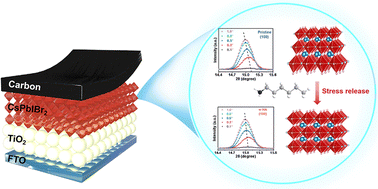
Chem. Commun., 2024,60, 4954-4957
https://doi.org/10.1039/D4CC01012D
Self-assembled halide perovskite quantum dots in polymer thin films showing temperature-controlled exciton recombination
Spontaneous assembly formation and thermal dissociation of self-assemblies of lead halide perovskite quantum dots embedded in a polymer host reversibly modulate the photoluminescence color, spectral maxima, and lifetime.

Chem. Commun., 2023,59, 13831-13834
https://doi.org/10.1039/D3CC02621C
Mechanical milling processed highly luminescent Cs–Pb–Br perovskite emitters
We report well-dispersed highly emitting perovskite emitters synthesized via the surfactant-assisted ball-milling method.

Chem. Commun., 2023,59, 11827-11830
https://doi.org/10.1039/D3CC01345F
A chiral two-dimensional perovskite-like lead-free bismuth(III) iodide hybrid with high phase transition temperature
[(S)-3-Aminopyrrolidinium I]2Bi2/3I4 is a novel chiral two-dimensional perovskite-like lead-free bismuth(III) iodide hybrid showing a high phase transition temperature and a narrow bandgap.

Chem. Commun., 2023,59, 10295-10298
https://doi.org/10.1039/D3CC02798H
Ionic liquid enables high-performance, self-powered CsPbBr3 perovskite nanonet photodetector
By passivating the nanonet with ionic liquid, the optimal PD exhibits the best performance with a switch ratio of about 1.35 × 106, a LDR extending to 140 dB, and responsivity and detectivity values of 0.19 A W−1 and 4.31 × 1012 Jones, respectively.
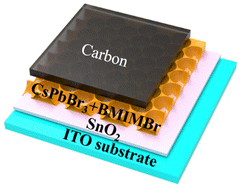
Chem. Commun., 2023,59, 8544-8547
https://doi.org/10.1039/D3CC02094K
Circularly polarized luminescence and nonlinear optical harmonic generation based on chiral zinc halides
The transfer of chirality from organics breaks inherent symmetry, leading to clear second-order NLO responses for chiral zinc halides. Additionally, successful CPL can be induced by doping chiral zinc halides with Sb3+ containing 5s2 electrons.

Chem. Commun., 2023,59, 7447-7450
https://doi.org/10.1039/D3CC01461D
Surface termination passivation of imidazole-based diiodide enabling efficient inverted perovskite solar cells
Efficient and stable Cs/FA-based inverted PSCs were developed by introducing imidazole diiodide (APDI) for surface termination passivation.
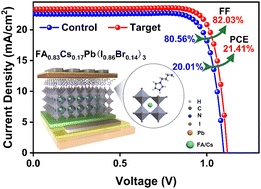
Chem. Commun., 2023,59, 6580-6583
https://doi.org/10.1039/D3CC01379K
Hexachlorotriphosphazene-assisted buried interface passivation for stable and efficient wide-bandgap perovskite solar cells
A buried interface treatment by hexachlorotriphosphazene is developed to suppress the open-circuit voltage (Voc) loss in wide bandgap perovskite solar cells (PerSCs). The PerSCs include a 1.67 eV absorber and deliver a high efficiency of 21.47%.

Chem. Commun., 2023,59, 6255-6258
https://doi.org/10.1039/D3CC01100C
How fast do defects migrate in halide perovskites: insights from on-the-fly machine-learned force fields
Machine-learned force fields are used to explain the effects that defect types and perovskite compositions have on the migration of point defects in inorganic halide perovskites.
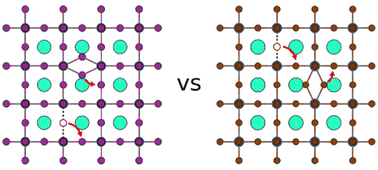
Chem. Commun., 2023,59, 4660-4663
https://doi.org/10.1039/D3CC00953J
Zero-dimensional Cu(I)-based organometallic halide with green cluster-centred emission for high resolution X-ray imaging screens
Zero-dimensional cupper(I) organometallic metal halide, with a perovskite-related structure, exhibits an efficient green cluster-centred emission for next-generation X-ray imaging screens.
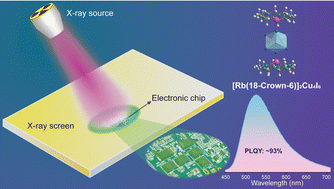
Chem. Commun., 2023,59, 4447-4450
https://doi.org/10.1039/D3CC00730H
One-dimensional organic metal halide nanoribbons with dual emission
A 1D organic metal halide hybrid (C8H28N5Pb3Cl11) containing metal halide nanoribbons has been developed to exhibit efficient dual emission.

Chem. Commun., 2023,59, 3711-3714
https://doi.org/10.1039/D3CC00044C
Crystal structure engineering of metal halide perovskites for photocatalytic organic synthesis
We investigated the effect of the crystal structure in Cs3BiBr6 and Cs3Bi2Br9 on the photocatalytic performance toward selective benzyl oxidation.

Chem. Commun., 2023,59, 3122-3125
https://doi.org/10.1039/D3CC00468F
MACl enhanced electron extraction in all-inorganic Cs2AgBiBr6 perovskite photovoltaics
Organic-halide treatment is used to maximize electron extraction of Cs2AgBiBr6 solar cells with a PCE of 2.03% and excellent long-term stability.

Chem. Commun., 2023,59, 1173-1176
https://doi.org/10.1039/D2CC06432D
Three-dimensional narrow-bandgap perovskite semiconductor ferroelectric methylphosphonium tin triiodide for potential photovoltaic application
We synthesized a novel A-site 3D OIHP ferroelectric, methylphosphonium tin triiodide (MPSnI3), with a narrow bandgap of 1.43 eV.
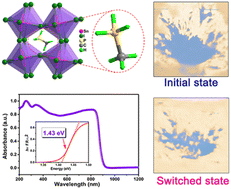
Chem. Commun., 2023,59, 920-923
https://doi.org/10.1039/D2CC06408A
In situ formation of inorganic healing overlayer for interface-stabilized all-inorganic CsPbIBr2 perovskite solar cells
A perovskite layer functionalized to be an outermost screen can strongly affect the capacity of the underlying device to avoid becoming decomposed under external stimuli, and subsequently affect the photovoltaic performance as well.
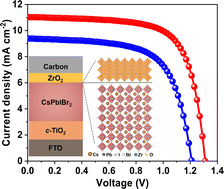
Chem. Commun., 2022,58, 13891-13894
https://doi.org/10.1039/D2CC05993B
About this collection
Perovskite materials are ubiquitous in a variety of research fields such as magnetism, ionic and electronic conduction, and catalysis. Hybrid organic-inorganic perovskites have also attracted an explosion of interest due to their potential applications in low cost solar cells. Research in these fields has demonstrated the flexibility and versatility of the perovskite structure, which allows the structure and properties to be tailored through appropriate chemical manipulations.
This collection highlights outstanding research and advances in all chemical aspects of perovskites research, and interdisciplinary work where there is a significant chemistry element.